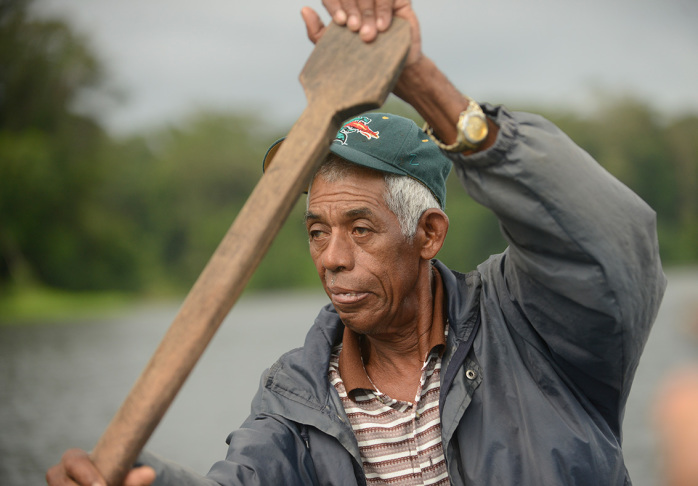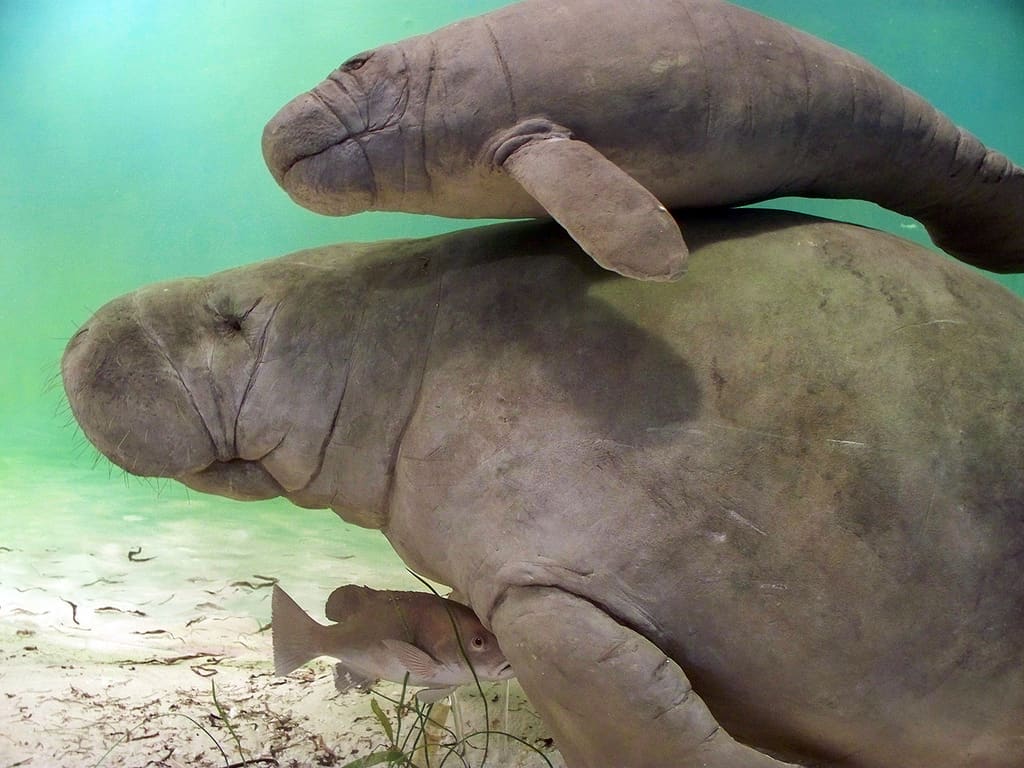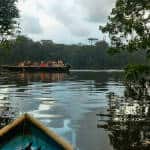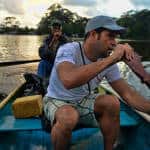LIMÓN – In his home in the tiny barrio of Limoncito, a few miles away from Costa Rica’s Atlantic coast, 8-year-old Aldeir Cortés is staring through a portal into an underwater world. Despite his proximity to the coast, Cortés has never seen the bulging gray creatures floating across his television screen, but he likes how they seem to smile at him.
From the show’s narrator, Cortés learns that the animals are manatees, endangered aquatic herbivores also known as sea cows. He also learns they live in small numbers in Costa Rica, in the rivers and the ocean close to his home.
The next day at school, Cortés can’t stop thinking about the manatees. Neither can his classmate, Fabiola Salas, 9, who had seen the same TV documentary. So the pair teamed up to discover everything they could about these marine mammals. When the Barrio Limoncito School held a science fair, the two shared everything they learned, along with a proposal to help save them.
“We thought the manatee should be a national symbol,” Cortés said. “We thought if more people were aware of it, we could save it in Costa Rica.”
Cortés and Salas teamed up with their teachers, their country’s lawmakers and manatee experts to draft a bill to make the sea cow Costa Rica’s national marine mammal. They hoped the new legislation would bring awareness to the animal’s dire need for conservation and create river sanctuaries to help protect the endangered species.
Marine biologists threw their support behind the bill, and a Limón lawmaker jumped in to sponsor it. But three years after that happened, the proposal still has not become law. On Tuesday, lawmakers will decide its final fate.
Ensconced in a tangle of vines, trees and mangrove leaves, the canals of Tortuguero National Park in Costa Rica’s northern Caribbean region look and feel like an unexplored wilderness. But sitting in a dugout canoe with 74-year-old nature guide Bill Sambola, every tree, animal and flower suddenly becomes familiar with a name and personality.
“Hello Mr. Heron,” Sambola shouts as a long-legged bird swoops down from a tree. “Have a nice day, Mr. Sloth,” he says, as we drift past a boat full of tourists heavily armed with camera gear, firing shots at the furry lump hidden in a tree.
Though wildlife abounds in the park, neither Sambola nor Alex Gómez – a mammal biology professor from Costa Rica’s National University and one of the bill’s project managers – expect to find any manatees. As the country’s premier manatee expert, Gómez has only spotted the mammals three times in Costa Rican waters.
Once home to a sizable population of West Indian manatees, Costa Rica’s Caribbean canals now support fewer than 20, experts believe. Even in Tortuguero, Costa Rica’s inland manatee stronghold, finding just one sea cow can take weeks of dedicated searching.
But finding evasive creatures is Sambola’s specialty. With enough time, he claims, he can lead us to any animal living in Tortuguero. In just a few days he can find us a manatee; with a few more, he can lead us to a jaguar.
Before Sambola was leading tourists into the jungle for photo shoots, he spent almost 50 years shooting wildlife with bullets, trading their pelts in the then-booming Panamanian fur market. For every creature Sambola points out on his tours, he can also tell you how to track it, kill it and cook it. For their valuable pelts, jungle cats were once a hunter’s ultimate prize, but hunting manatees for meat was also common.
“I can’t tell you very much about manatees,” Sambola said with a toothy laugh. “What I can tell you is that the manatee is a very delicious animal.”

Weighing up to 1,200 pounds, an adult manatee can feed a family for weeks, but catching one is arduous. Lacking harpoon guns large enough to kill a full-grown manatee, Tortuguero hunters speared them and strung logs onto their backs. When a manatee would attempt to surface, hunters pulled the rope tight, positioning the log directly over the sea cow, forcing it underwater. After 15 minutes without a breath, the drowned manatee would float to the top of the water.
For years, hunters decimated the region’s manatees, and by the 1970s the species was considered extinct in Costa Rica. But as hunters were killing off the last of the sea cows in Tortuguero, conservationists were just starting to lay the groundwork to protect the area’s important turtle nesting beaches.
Over the next three decades, Tortuguero converted from a hunter’s playground into an eco-tourist’s paradise. Many of the logging companies left, fur trading became illegal and some of the area’s wildlife started to recover.
In 1995 a group of researchers from the Berkeley campus of the University of California began studying the canals. They discovered that a small group of manatees had returned to Tortuguero, but the new manatees were different. Unlike their hunted ancestors, the modern Tortuguero manatee avoids humans at all costs.
The creatures’ elusiveness has made them difficult to study. In 2004, Gómez and a group of researchers from the U.S. Geological Survey led an expedition to tag manatees in Tortuguero. After a week of searching, they couldn’t find a single one.
“There aren’t easy places to catch manatees in Costa Rica,” said Robert Bonde, a Florida-based federal research biologist with the U.S. Geological Survey, who has studied manatees for more than 30 years. “Radio tags and research trips are expensive, so that makes it hard to get funding.”
But although biologists know very little about Costa Rica’s manatees, most Costa Ricans know almost nothing. According to Gómez, most of the people he talks to are unaware that manatees live in Costa Rica. Some don’t even know what a manatee is.
Even in Tortuguero, Sambola says he talks to people who seem confused.
“Just last week a friend came to me looking for advice about manatees,” Sambola told us, laughing again as we drifted down the canals. “The fruit in his garden had gone missing and he was sure a sneaky manatee had walked up and stolen it. I didn’t tell him that manatees only live in the water. I knew the boys up the street had taken his fruit, but I didn’t tell him anything.”
The primary reason we know manatees still live in Costa Rica’s rivers is because occasionally one will turn up dead.
This happened most recently in April, when park rangers found a 10-foot juvenile female floating belly up in one of the park’s canals. Its flippers pointed straight to the sky, the rangers reported, stiff with rigor mortis.
“We don’t know for sure how many manatees are left in Tortuguero,” Gómez said. “What we do know is that the unnatural death of even one is a significant blow to the population.”
Though manatee hunting has fallen out of favor, the marine mammals still face human threats to their survival.
In 2007, Gómez was called to Tortuguero to investigate the death of three young manatees. Though the cause of death was never conclusively determined, dead fish and traces of chemicals found at the scene suggested the likely culprit might be one of the nearby banana or pineapple plantations.
“Most likely they released a large amount of chemicals all at once and it killed the manatees,” Gómez said. “This case was an extreme, but we worry that chemicals have had a long-term affect on the vegetation.”
Gómez has research to back up his worries about agrochemicals. He spent a year with Sambola in his dugout canoe, tracking the location of mangrove leaves the manatees were eating. He found that Costa Rican manatees have different diets than other West Indian manatees, due to a shortage in their normal food sources, possibly from pesticides.
While toxins in the water are a chronic threat to the manatees’ habitat, boat traffic in the canals presents a more immediate hazard to a sea cow’s survival.
The absence of roads and a defunct railroad mean that everything going in and out of Tortuguero travels by boat. While the boats supply the small villages and feed Tortuguero’s tourism industry, they also litter the canals’ surfaces with sharp boat propellers. A collision with a fast-moving boat can be lethal for a manatee, and a propeller was likely what killed the dead female discovered in April.
“There are no speed restrictions and the murky water makes it impossible to see a manatee underwater,” Gómez said. “When most people hit a manatee, they think it is just a log or a rock and they blow right by.”
Though it was the muddy water that initially saved manatees from hunters, low visibility in Costa Rica’s rivers has become a huge obstacle for manatee conservationists.
“In Florida people learned a long time ago that manatees could be used for eco-tourism instead of putting them into a pot,” Bonde said. “But [in Florida], with the clear water, you can see manatees from the surface. It would be a hard sell to put a photo of a manatee on a tour poster in Costa Rica.”
With no money to be made from manatee tours, Tortuguero residents and tour operators have been less than enthusiastic about adopting boat speed limits and canal restrictions that would help save manatees. The proposed manatee bill would put parts of Tortuguero National Park under complete protection from boats and other human interference. It would also create restrictions on agrochemical dumping.
But Gómez and other conservationists believe the bill’s real value lies in the education programs to spread awareness about manatees.
“I still remember when I was in school learning the alphabet with an animal for each letter. Back then the ‘M’ was for monkey,” Bonde said. “Today, in Florida, they have changed it to manatee so no child in the public school system grows up not knowing what a manatee is. Things like that can make a difference in the long run. Something like that could help save the manatees in Costa Rica.”
The Barrio Limoncito School is 2 kilometers (1.2 miles) from the Caribbean coastal hub of Limón. Beneath the school’s rusting tin roof and dilapidated walls is the dimly lit science classroom where the manatee bill was born.
Now 12 and 13 and in high school, Cortés and Salas wonder if they will ever see their dream become a reality. For them, the bill has now taken on a new meaning. “It just seems like no one in the rest of the country cares about Limón,” Salas said. “I think maybe if this passed it would show people here that we aren’t as forgotten as people think. Maybe residents in other provinces would start to pay more attention.”
Though Cortés and Salas came up with the bill, it was their science teacher, Yvette Ibarra, who helped get the idea off the ground.
In the last decade, Ibarra says she has watched her school and her neighborhood start to crumble. She has seen her hometown converted from a tranquil beach village into a drug-trafficking hot spot, and she has watched some of her brightest students join violent gangs.
“This bill is about more than manatees,” Ibarra said. “It is about showing these kids that their voices can be heard.”
Ibarra solicited Gómez’s help, and together they started the process of drafting a popular initiative bill, which allows everyday citizens to propose legislation if they can get enough signatures of support. Since their bill presented no political controversy, the pair thought they could get it passed within a year. That was 2011.
They put the bill into the hands of Rodrigo Pinto, a lawmaker from Limón. He brought it to the Legislative Assembly’s Science Commission in 2011, but without any strategic political importance, it was kept off the agenda for years.
“Mr. Pinto was interested in supporting the children from his home province and thought the bill was a great way to do that,” said Gustavo Mora, Pinto’s legal adviser who drafted the bill. “But it is more symbolic than anything, so there has not been much interest in passing it quickly.”
Over the years, Ibarra made multiple trips to the capital to petition for the bill. Sometimes she brought students, other times she went alone. She sent letters, she called Pinto and Gómez for updates, and she waited.
In 2013, after a year and a half of waiting, Ibarra took a group of students to the Casa Presidencial in southeastern San José to meet with then-President Laura Chinchilla. The group stood outside the gates of Casa Presidencial until Chinchilla agreed to meet with them. The president shook the children’s hands, listened to the teacher’s requests and promised she would make the manatee bill a law before she left office.
Several months later, the completed bill was passed through commission, but despite Chinchilla’s promise, it failed to make its way onto the legislative agenda before she left office on May 8.
“This bill is not complicated,” Ibarra said. “The only reason it isn’t a law yet is because of a lack of political will. Lawmakers see a bill proposed by children from a poor coastal province and somehow it doesn’t register as important.”
In May, the change in government meant another trip to San José and another petition for the bill’s passage. Gómez met with leaders in the Legislative Assembly, and begged them to add it to the agenda.
“They seemed interested, but so did the government before,” he said. “We didn’t have high hopes, but they surprised us and passed it through a first round of votes last week.”
A final round of voting is now scheduled for Tuesday, but that vote could be delayed until the end of the week. According to Gómez, the bill passed unanimously in the first round and is unlikely to meet opposition in the final vote.
If it passes and President Luis Guillermo Solís signs it into law, the manatee would become Costa Rica’s first marine symbol and the first national symbol for the province of Limón.
“Just look at the manatee. It’s calm, it’s giant, it’s sweet. It was forgotten but now is starting to get attention,” Ibarra said. “It’s a creature full of love and full of peace. That’s what we want for Limón – lots and lots of peace.”





